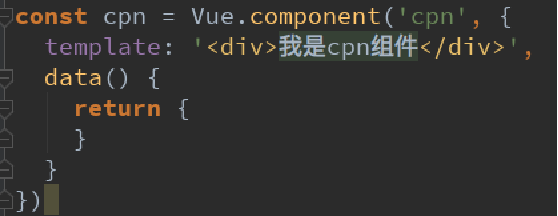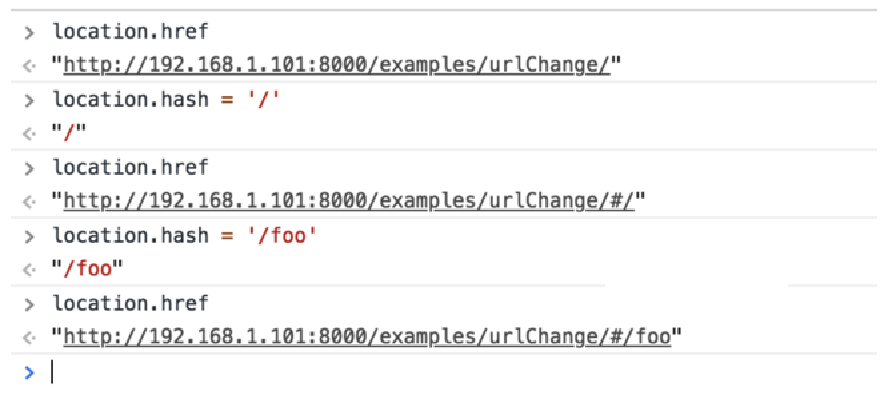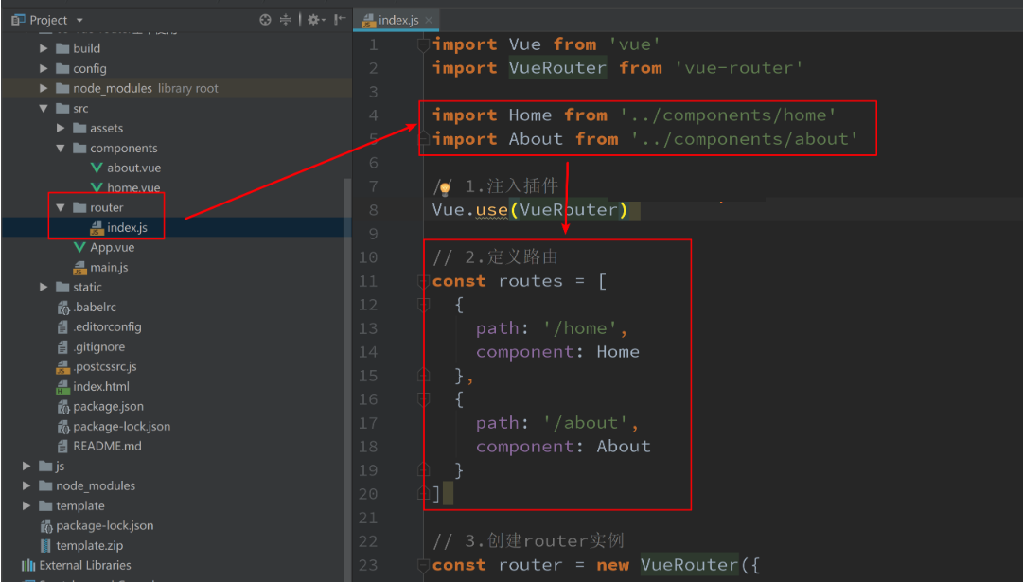vue-脚手架和Router路由
一. Vue CLI
1.1. runtime-compiler和runtime-only的区别

简单总结
如果在之后的开发中,你依然使用template,就需要选择Runtime-Compiler
如果你之后的开发中,使用的是.vue文件夹开发,那么可以选择Runtime-only

ESLint到底是什么?
代码规范的自动检测
关闭ESLint

Runtime-Compiler
template --解析>> ast(抽象语法树) -> render -> vdom -> 真实DOM
runtime-only(性能更多,代码量更少)
render: (h) => h--> createElement(函数,创建元素)
1.普通用法 createElement('标签',{标签的属性},[''])


写法

2.传入组件对象:

render和template
Runtime-Compiler 和 Runtime-only

为什么存在这样的差异呢?
我们需要先理解Vue应用程序是如何运行起来的。
Vue中的模板如何最终渲染成真实DOM。
我们来看下面的一幅图。
Vue程序运行过程

render函数的使用



npm run build

npm run dev

修改配置:webpack.base.conf.js起别名

1.2. Vue CLI3
如何通过CLI3创建项目
vue create my-project

CLI3的目录结构
配置文件: 1.Vue UI 2.隐藏的配置文件 3.自定义vue.config.js
认识Vue CLI3
今年8月份刚刚发布

vue-cli 3 与 2 版本有很大区别
vue-cli 3 是基于 webpack 4 打造,vue-cli 2 还是 webapck 3
vue-cli 3 的设计原则是“0配置”,移除的配置文件根目录下的,build和config等目录
vue-cli 3 提供了 vue ui 命令,提供了可视化配置,更加人性化
移除了static文件夹,新增了public文件夹,并且index.html移动到public中
Vue CLI3

删除自己的项目配置

目录结构详解

配置去哪里了?

自定义配置:起别名

箭头函数与this指向
箭头函数的基本使用
<script>
// 箭头函数: 也是一种定义函数的方式
// 1.定义函数的方式: function
const aaa = function () {
}
// 2.对象字面量中定义函数
const obj = {
bbb()
}
}
// 3.ES6中的箭头函数
const ccc = (参数列表) => {
}
const ccc = () => {
}
</script>
箭头函数参数和返回值
<script>
// 1.参数问题:
// 1.1.放入两个参数
const sum = (num1, num2) => {
return num1 + num2
}
1.2.放入一个参数 (小括号可以省略掉的)
const power = num => {
return num * num
}
// 2.函数中
// 2.1.函数代码块中有多行代码时
const test = () => {
1.打印Hello World
console.log('Hello World');
2.打印Hello Vuejs
console.log('Hello Vuejs');
}
// 2.2.函数代码块中只有一行代码
const mul = (num1, num2) => {
return num1 + num2
}
const mul = (num1, num2) => num1 * num2
console.log(mul(20, 30));
const demo = () => {
console.log('Hello Demo');
}
const demo = () => console.log('Hello Demo')
console.log(demo());
</script>
箭头函数中的this的使用
<script>
什么时候使用箭头
setTimeout(function () {
console.log(this);
}, 1000)
setTimeout(() => {
console.log(this);
}, 1000)
问题: 箭头函数中的this是如何查找的了?
答案: 向外层作用域中, 一层层查找this, 直到有this的定义.
const obj = {
aaa() {
setTimeout(function () {
console.log(this); // window
})
setTimeout(() => {
console.log(this); // obj对象
})
}
}
obj.aaa()
const obj = {
aaa() {
setTimeout(function () {
setTimeout(function () {
console.log(this); // window
})
setTimeout(() => {
console.log(this); // window
})
})
setTimeout(() => {
setTimeout(function () {
console.log(this); // window
})
setTimeout(() => {
console.log(this); // obj
})
})
}
}
obj.aaa()
</script>
二. Vue-Router
2.1. 什么是前端路由
什么是路由?
说起路由你想起了什么?
路由是一个网络工程里面的术语。
路由(routing)就是通过互联的网络把信息从源地址传输到目的地址的活动. --- 维基百科
额, 啥玩意? 没听懂
在生活中, 我们有没有听说过路由的概念呢? 当然了, 路由器嘛.
路由器是做什么的? 你有想过吗?
路由器提供了两种机制: 路由和转送.
路由是决定数据包从来源到目的地的路径.
转送将输入端的数据转移到合适的输出端.
路由中有一个非常重要的概念叫路由表.
路由表本质上就是一个映射表, 决定了数据包的指向.

后端路由阶段
早期的网站开发整个HTML页面是由服务器来渲染的.
服务器直接生产渲染好对应的HTML页面, 返回给客户端进行展示.
但是, 一个网站, 这么多页面服务器如何处理呢?
一个页面有自己对应的网址, 也就是URL.
URL会发送到服务器, 服务器会通过正则对该URL进行匹配, 并且最后交给一个Controller进行处理.
Controller进行各种处理, 最终生成HTML或者数据, 返回给前端.
这就完成了一个IO操作.
上面的这种操作, 就是后端路由.
当我们页面中需要请求不同的路径内容时, 交给服务器来进行处理, 服务器渲染好整个页面, 并且将页面返回给客户顿.
这种情况下渲染好的页面, 不需要单独加载任何的js和css, 可以直接交给浏览器展示, 这样也有利于SEO的优化.
后端路由的缺点:
一种情况是整个页面的模块由后端人员来编写和维护的.
另一种情况是前端开发人员如果要开发页面, 需要通过PHP和Java等语言来编写页面代码.
而且通常情况下HTML代码和数据以及对应的逻辑会混在一起, 编写和维护都是非常糟糕的事情.
前端路由阶段
前后端分离阶段:
随着Ajax的出现, 有了前后端分离的开发模式.
后端只提供API来返回数据, 前端通过Ajax获取数据, 并且可以通过JavaScript将数据渲染到页面中.
这样做最大的优点就是前后端责任的清晰, 后端专注于数据上, 前端专注于交互和可视化上.
并且当移动端(iOS/Android)出现后, 后端不需要进行任何处理, 依然使用之前的一套API即可.
目前很多的网站依然采用这种模式开发.
单页面富应用阶段:
其实SPA最主要的特点就是在前后端分离的基础上加了一层前端路由.
也就是前端来维护一套路由规则.
前端路由的核心是什么呢?
改变URL,但是页面不进行整体的刷新。
如何实现呢?
URL的hash
URL的hash
URL的hash也就是锚点(#), 本质上是改变window.location的href属性.
我们可以通过直接赋值location.hash来改变href, 但是页面不发生刷新

HTML5的history模式:pushState
history接口是HTML5新增的, 它有五种模式改变URL而不刷新页面.
history.pushState()

HTML5的history模式:replaceState
history.replaceState()

HTML5的history模式:go
history.go()

2.2. 路由的基本配置
安装vue-router
认识vue-router
目前前端流行的三大框架, 都有自己的路由实现:
Angular的ngRouter
React的ReactRouter
Vue的vue-router
当然, 我们的重点是vue-router
vue-router是Vue.js官方的路由插件,它和vue.js是深度集成的,适合用于构建单页面应用。
我们可以访问其官方网站对其进行学习: https://router.vuejs.org/zh/
vue-router是基于路由和组件的
路由用于设定访问路径, 将路径和组件映射起来.
在vue-router的单页面应用中, 页面的路径的改变就是组件的切换.
安装和使用vue-router
因为我们已经学习了webpack, 后续开发中我们主要是通过工程化的方式进行开发的.
所以在后续, 我们直接使用npm来安装路由即可.
步骤一: 安装vue-routernpm
install vue-router --save
步骤二: 在模块化工程中使用它(因为是一个插件, 所以可以通过Vue.use()来安装路由功能)
第一步:导入路由对象,并且调用 Vue.use(VueRouter)
第二步:创建路由实例,并且传入路由映射配置
第三步:在Vue实例中挂载创建的路由实例
import Vue from 'vue'
import VueRouter from 'vue-router'
Vue.use(VueRouter)
路由框架搭建

使用vue-router的步骤:
第一步: 创建路由组件
第二步: 配置路由映射: 组件和路径映射关系
第三步: 使用路由: 通过
Vue.use -> 创建VueRouter对象 -> 挂在到Vue实例上
创建router实例

挂载到Vue实例中

配置映射关系: 1.创建组件 2.配置映射关系 3.使用router-link/router-view
步骤一:创建路由组件

步骤二:配置组件和路径的映射关系

最终效果如下

2.3. 细节处理
默认路由: redirect
路由的默认路径
我们这里还有一个不太好的实现:
默认情况下, 进入网站的首页, 我们希望
但是我们的实现中, 默认没有显示首页组件, 必须让用户点击才可以.
如何可以让路径默认跳到到首页, 并且
非常简单, 我们只需要配置多配置一个映射就可以了.

配置解析:
我们在routes中又配置了一个映射.
path配置的是根路径: /
redirect是重定向, 也就是我们将根路径重定向到/home的路径下, 这样就可以得到我们想要的结果了.
mode: history
我们前面说过改变路径的方式有两种:
URL的hash
HTML5的history
默认情况下, 路径的改变使用的URL的hash.
如果希望使用HTML5的history模式, 非常简单, 进行如下配置即可:


router-link -> tag/replace/active-class
router-link补充
在前面的<router-link>中, 我们只是使用了一个属性: to, 用于指定跳转的路径.
<router-link>还有一些其他属性:
tag: tag可以指定<router-link>之后渲染成什么组件, 比如上面的代码会被渲染成一个<li>元素, 而不是<a>
replace: replace不会留下history记录, 所以指定replace的情况下, 后退键返回不能返回到上一个页面中
active-class: 当<router-link>对应的路由匹配成功时, 会自动给当前元素设置一个router-link-active的class,
设置active-class可以修改默认的名称.
在进行高亮显示的导航菜单或者底部tabbar时, 会使用到该类.
但是通常不会修改类的属性, 会直接使用默认的router-link-active即可.

修改linkActiveClass
该class具体的名称也可以通过router实例的属性进行修改

代码
路由的使用
components/Home.vue
<template>
<div>
<h2>我是首页</h2>
<p>我首页内容,哈哈</p>
</div>
</template>
<script>
export default {
name: "Home"
}
</script>
<style scoped>
</style>
components/About.vue
<template>
<div>
<h2>我是关于</h2>
<p>我关于内容,哈哈</p>
</div>
</template>
<script>
export default {
name: "About"
}
</script>
<style scoped>
</style>
路由/index.js
//配置路由相关的信息
import VueRouter from 'vue-router'
import Vue from "vue";
import Home from "../components/Home";
import About from "../components/About";
//1.通过我们的vue.ues(传入插件),安装插件
Vue.use(VueRouter)
//2.创建VueRouter对象
const routes = [
{
//路由的默认路径
path: '',
redirect: '/home'
},
{
path: '/home',
component: Home
}, {
path: '/about',
component: About
}
]
const router = new VueRouter({
//配置路由和组件之间的应用关系
routes,
mode: 'history',
linkActiveClass: 'active'
})
//3.将我们的router对象传入到Vue实例中
export default router
App.vue
<template>
<div id="app">
<h2>我是app组件</h2>
<!-- <router-link to="/home" tag="button" replace active-class="active">首页</router-link>-->
<!-- <router-link to="/about" tag="button" replace active-class="active">关于</router-link>-->
<router-link to="/home" tag="button" replace>首页</router-link>
<router-link to="/about" tag="button" replace>关于</router-link>
<router-view></router-view>
</div>
</template>
<script>
export default {
name: 'App'
}
</script>
<style>
/*.router-link-active {*/
/* color: red;*/
/*}*/
.active {
color: red;
}
</style>
路由的懒加载
认识路由的懒加载
官方给出了解释:
当打包构建应用时,Javascript 包会变得非常大,影响页面加载。
如果我们能把不同路由对应的组件分割成不同的代码块,然后当路由被访问的时候才加载对应组件,这样就更加高效了
官方在说什么呢?
首先, 我们知道路由中通常会定义很多不同的页面.
这个页面最后被打包在哪里呢? 一般情况下, 是放在一个js文件中.
但是, 页面这么多放在一个js文件中, 必然会造成这个页面非常的大.
如果我们一次性从服务器请求下来这个页面, 可能需要花费一定的时间, 甚至用户的电脑上还出现了短暂空白的情况.
如何避免这种情况呢? 使用路由懒加载就可以了.
路由懒加载做了什么?
路由懒加载的主要作用就是将路由对应的组件打包成一个个的js代码块.
只有在这个路由被访问到的时候, 才加载对应的组件
路由懒加载的效果

懒加载的方式
方式一: 结合Vue的异步组件和Webpack的代码分析.
const Home = resolve => { require.ensure(['../components/Home.vue'], () => { resolve(require('../components/Home.vue')) })};
方式二: AMD写法
const About = resolve => require(['../components/About.vue'], resolve);
方式三: 在ES6中, 我们可以有更加简单的写法来组织Vue异步组件和Webpack的代码分割.
const Home = () => import('../components/Home.vue')
import Vue from 'vue'
import Router from 'vue-router'
// import Home from "../components/Home";
// import About from "../components/About";
// import User from "../components/User";
//推荐这种写法
const Home = ()=> import('../components/Home')
const About = ()=> import('../components/About')
const User = ()=> import('../components/User')
Vue.use(Router)
const routes = [
{
path: '',
redirect: '/home'
},{
path: '/home',
component: Home
},{
path: '/about',
component: About
},{
path: '/user/:abc',
component: User,
}
]
export default new Router({
routes,
mode:'history',
linkActiveClass: 'active'
})
2.4. 动态路由
/user/:id
this.$route.params.id
路由代码跳转
有时候, 页面的跳转可能需要执行对应的JavaScript代码, 这个时候, 就可以使用第二种跳转方式了
比如, 我们将代码修改如下:

动态路由
在某些情况下,一个页面的path路径可能是不确定的,比如我们进入用户界面时,希望是如下的路径:
/user/aaaa或/user/bbbb
除了有前面的/user之外,后面还跟上了用户的ID
这种path和Component的匹配关系,我们称之为动态路由(也是路由传递数据的一种方式)。

2.5. 路由嵌套
children: []
认识路由嵌套
嵌套路由是一个很常见的功能
比如在home页面中, 我们希望通过/home/news和/home/message访问一些内容.
一个路径映射一个组件, 访问这两个路径也会分别渲染两个组件.
路径和组件的关系如下:

嵌套路由实现
定义两个组件:





嵌套默认路径
嵌套路由也可以配置默认的路径, 配置方式如下:

路由代码
import Vue from 'vue'
import Router from 'vue-router'
// import Home from "../components/Home";
// import About from "../components/About";
// import User from "../components/User";
//推荐这种写法
const Home = () => import('../components/Home')
//HOme子组件
const HomeNews = ()=> import('../components/HomeNews')
const HomeMessage = ()=> import('../components/HomeMessages')
const About = () => import('../components/About')
const User = () => import('../components/User')
Vue.use(Router)
const routes = [
{
path: '',
redirect: '/home'
}, {
path: '/home',
component: Home,
children: [
{
path: '',
redirect:'news'
},
{
path: 'news',
component: HomeNews
}, {
path: 'message',
component: HomeMessage
}
]
}, {
path: '/about',
component: About
}, {
path: '/user/:abc',
component: User,
}
]
export default new Router({
routes,
mode: 'history',
linkActiveClass: 'active'
})
2.6. 参数的传递
params
query -> URL
URL:
协议://主机:端口/路径?查询
scheme://host:port/path?query#fragment
准备工作
为了演示传递参数, 我们这里再创建一个组件, 并且将其配置好
第一步: 创建新的组件Profile.vue
<template>
<div>
<h2>我是profile组件</h2>
<h2>{{$route.query}}</h2>
</div>
</template>
<script>
export default {
name: "Profile"
}
</script>
<style scoped>
</style>
第二步: 配置路由映射
import Vue from 'vue'
import Router from 'vue-router'
// import Home from "../components/Home";
// import About from "../components/About";
// import User from "../components/User";
//推荐这种写法
const Home = () => import('../components/Home')
//HOme子组件
const HomeNews = () => import('../components/HomeNews')
const HomeMessage = () => import('../components/HomeMessages')
const About = () => import('../components/About')
const User = () => import('../components/User')
const Profile = () => import('../components/Profile')
Vue.use(Router)
const routes = [
{
path: '',
redirect: '/home'
}, {
path: '/home',
component: Home,
children: [
{
path: '',
redirect: 'news'
},
{
path: 'news',
component: HomeNews
}, {
path: 'message',
component: HomeMessage
}
]
}, {
path: '/about',
component: About
}, {
path: '/user/:id',
component: User,
}, {
path: '/profile',
component: Profile
}
]
export default new Router({
routes,
mode: 'history',
linkActiveClass: 'active'
})
第三步: 添加跳转的



<template>
<div id="app">
<h2>我是App组件</h2>
<!-- <button @click="homeClick">首页</button>-->
<!-- <button @click="aboutClick">关于</button>-->
<router-link to="/home">首页</router-link>
<router-link to="/about">关于</router-link>
<!-- <router-link :to="'/user/'+user_id">用户</router-link>-->
<!-- <router-link to="/profile">档案</router-link>-->
<!-- <router-link :to="{path: '/profile' ,query: {name: 'why', age: 18 ,height: 1.88}}">档案</router-link>-->
<button @click="userClick">用户</button>
<button @click="profileClick">档案</button>
<router-view></router-view>
</div>
</template>
<script>
export default {
name: 'App',
data() {
return {
user_id: 'zhangsan',
}
},
// methods: {
// homeClick() {
// // this.$router.push('/home')
// this.$router.replace('/home')
// console.log("homeClick");
// },
// aboutClick() {
// // this.$router.push('/about')
// this.$router.replace('/about')
// console.log('aboutClick');
// },
// }
methods: {
userClick(){
this.$router.push('/user/' + this.user_id)
},
profileClick() {
this.$router.push({
path: '/profile',
query: {name: 'why', age: 18 ,height: 1.88}
})
},
}
}
</script>
<style>
.active {
color: red;
}
</style>
传递参数的方式
传递参数主要有两种类型: params和query
params的类型:
配置路由格式: /router/:id
传递的方式: 在path后面跟上对应的值
传递后形成的路径: /router/123, /router/abc
query的类型:
配置路由格式: /router, 也就是普通配置
传递的方式: 对象中使用query的key作为传递方式
传递后形成的路径: /router?id=123, /router?id=abc
如何使用它们呢? 也有两种方式:
传递参数方式一:

传递参数方式二: JavaScript代码

获取参数
获取参数通过$route对象获取的.
在使用了 vue-router 的应用中,路由对象会被注入每个组件中,赋值为 this.$route ,并且当路由切换时,路由对象会被更新。
通过$route获取传递的信息如下:

$route和$router是有区别的
$route和$router是有区别的
$router为VueRouter实例,想要导航到不同URL,则使用$router.push方法
$route为当前router跳转对象里面可以获取name、path、query、params等

2.7. 导航守卫
为什么要使用导航守卫
我们来考虑一个需求: 在一个SPA应用中, 如何改变网页的标题呢?
网页标题是通过<title>来显示的, 但是SPA只有一个固定的HTML, 切换不同的页面时, 标题并不会改变.
但是我们可以通过JavaScript来修改<<title>>的内容.window.document.title = '新的标题'.
那么在Vue项目中, 在哪里修改? 什么时候修改比较合适呢?
普通的修改方式:
我们比较容易想到的修改标题的位置是每一个路由对应的组件.vue文件中.
通过mounted声明周期函数, 执行对应的代码进行修改即可.
但是当页面比较多时, 这种方式不容易维护(因为需要在多个页面执行类似的代码).
有没有更好的办法呢? 使用导航守卫即可.
什么是导航守卫?
vue-router提供的导航守卫主要用来监听监听路由的进入和离开的.
vue-router提供了beforeEach和afterEach的钩子函数, 它们会在路由即将改变前和改变后触发.
导航守卫使用
我们可以利用beforeEach来完成标题的修改.
首先, 我们可以在钩子当中定义一些标题, 可以利用meta来定义
其次, 利用导航守卫,修改我们的标题.
导航钩子的三个参数解析:
to: 即将要进入的目标的路由对象.
from: 当前导航即将要离开的路由对象.
next: 调用该方法后, 才能进入下一个钩子


import Vue from 'vue'
import Router from 'vue-router'
// import Home from "../components/Home";
// import About from "../components/About";
// import User from "../components/User";
//推荐这种写法
const Home = () => import('../components/Home')
//HOme子组件
const HomeNews = () => import('../components/HomeNews')
const HomeMessage = () => import('../components/HomeMessages')
const About = () => import('../components/About')
const User = () => import('../components/User')
const Profile = () => import('../components/Profile')
Vue.use(Router)
const routes = [
{
path: '',
redirect: '/home'
}, {
path: '/home',
component: Home,
meta: {title: '首页'},
children: [
{
path: '',
redirect: 'news'
},
{
path: 'news',
component: HomeNews
}, {
path: 'message',
component: HomeMessage
}
]
}, {
path: '/about',
component: About,
meta: {title: '关于'},
}, {
path: '/user/:id',
component: User,
meta: {title: '用户'},
}, {
path: '/profile',
component: Profile,
meta: {title: '档案'}
}
]
const router = new Router({
routes,
mode: 'history',
linkActiveClass: 'active'
})
router.beforeEach((to, from, next) =>{
//matched[0]是因为路由嵌套问题
//从from跳转到to
document.title = to.matched[0].meta.title
next()
})
export default router
导航守卫补充
补充一:如果是后置钩子, 也就是afterEach, 不需要主动调用next()函数.
补充二: 上面我们使用的导航守卫, 被称之为全局守卫.
路由独享的守卫.
组件内的守卫.
更多内容, 可以查看官网进行学习:
https://router.vuejs.org/zh/guide/advanced/navigation-guards.html#%E8%B7%AF%E7%94%B1%E7%8B%AC%E4%BA%AB%E7%9A%84%E5%AE%88%E5%8D%AB
2.8. Keep-alive
keep-alive遇见vue-router
keep-alive 是 Vue 内置的一个组件,可以使被包含的组件保留状态,或避免重新渲染。
它们有两个非常重要的属性:
include - 字符串或正则表达,只有匹配的组件会被缓存
exclude - 字符串或正则表达式,任何匹配的组件都不会被缓存
router-view 也是一个组件,如果直接被包在 keep-alive 里面,所有路径匹配到的视图组件都会被缓存:

- 通过create声明周期函数来验证
2.9. TabBar的封装过程
TabBar实现思路
如果在下方有一个单独的TabBar组件,你如何封装
自定义TabBar组件,在APP中使用
让TabBar出于底部,并且设置相关的样式
2.TabBar中显示的内容由外界决定
定义插槽
flex布局平分TabBar
3.自定义TabBarItem,可以传入 图片和文字
定义TabBarItem,并且定义两个插槽:图片、文字。
给两个插槽外层包装div,用于设置样式。
填充插槽,实现底部TabBar的效果

TabBar实现思路
4.传入 高亮图片
定义另外一个插槽,插入active-icon的数据
定义一个变量isActive,通过v-show来决定是否显示对应的icon
5.TabBarItem绑定路由数据
安装路由:npm install vue-router —save
完成router/index.js的内容,以及创建对应的组件
main.js中注册router
APP中加入
6.点击item跳转到对应路由,并且动态决定isActive
监听item的点击,通过this.$router.replace()替换路由路径
通过this.$route.path.indexOf(this.link) !== -1来判断是否是active
7.动态计算active样式
封装新的计算属性:this.isActive ? {'color': 'red'} : {}
代码实现


URL:

C:\Users\Administrator\AppData\Roaming
vue init webpack project
runtime+compiler和runtime-only
template -> ast -> render -> virtual dom -> 真实DOM
vue2..21 -> vue2.x -> flow-type(facebook)
Vue3.x -> TypeScript(micro(微小)soft(软件))
future: 将来/未来
fut: 特性
rc -> run command
vcs -> version control system(版本控制git/svn)
什么是前端渲染, 什么是后端渲染?
- 后端渲染就是把整个网页渲染好直接给前端展示
- 前端渲染只从后端的api接口里面把数据请求过来,完了通过JS渲染出来


什么是前后端分离?
什么是前端路由, 什么是后端路由?

前端路由中url与组件的关系

完整的写法超链接
href -> hyper reference


